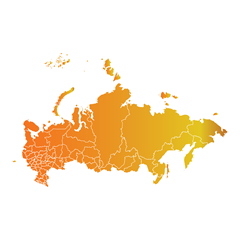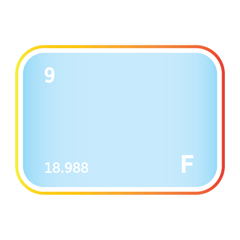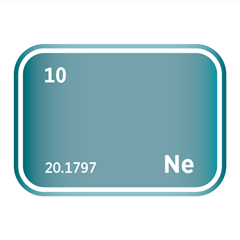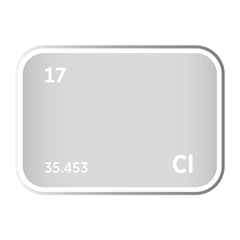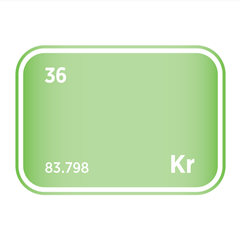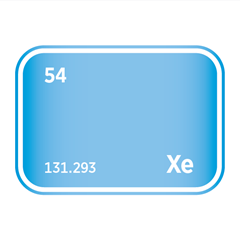Krypton
Critical Minerals and The Energy Transition
Navigating the Krypton Market
Due to its unique properties, Krypton, a rare noble gas, is essential in various high-tech and industrial applications. Predominantly used in lighting, krypton is a key component in energy-efficient fluorescent bulbs and high-performance flashlights, providing superior illumination. Its significance extends to the field of insulation, where krypton-filled windows offer excellent thermal performance, contributing to energy conservation in buildings. Additionally, krypton is vital in scientific research and technology, including high-speed photography and as a trace gas in atmospheric studies. The demand for krypton is driven by its specialised uses, yet it is influenced by its limited availability and the complexities of extraction from the air. The krypton market faces challenges such as supply limitations, price fluctuations, and the need for advanced production techniques. As the world moves towards energy efficiency and technological innovation, the krypton industry is at the cutting edge, striving to meet the demands of modern applications while ensuring sustainable resource management.
An introduction to krypton
Krypton demand and end-uses
Krypton is a colourless, odourless noble gas found in trace amounts in the Earth’s atmosphere. It is known for its chemical inertness, high atomic mass, and unique ability to emit bright light when electrically excited. Though produced and consumed in small volumes, krypton plays a valuable role in specialised applications across lighting, electronics, aerospace, insulation, and scientific research. Its distinctive physical and optical properties make it indispensable in sectors that rely on precision, performance, and environmental control.
One of krypton’s most well-established uses is in high-performance lighting systems, particularly high-intensity discharge (HID) lamps, airport runway lights, photographic flashes, and laser light sources. Krypton gas emits bright white light when electrically excited, producing a clean, concentrated light beam with excellent colour rendering. Krypton is used in krypton-filled incandescent bulbs and krypton–halogen lamps, which offer higher luminous efficacy and longer lifespan than standard argon-filled bulbs. While solid-state LED lighting has replaced many traditional systems, krypton remains in demand for specialist lighting where precise spectral output or high brightness is required.
In the laser and optics industry, krypton is used in excimer lasers, particularly krypton fluoride (KrF) lasers. These produce ultraviolet light in semiconductor photolithography, micromachining, and eye surgeries like LASIK. KrF lasers offer short wavelengths and high beam uniformity, enabling sub-micron precision and making krypton a critical component of advanced manufacturing and medical procedures.
Krypton is also used in energy-efficient insulation. When sealed between glass panes, krypton gas significantly reduces heat transfer due to its low thermal conductivity. Krypton-filled double or triple-glazed windows provide excellent thermal insulation for high-performance buildings, especially in colder climates where improved energy efficiency is a priority. Though more expensive than argon, krypton offers superior insulating performance in thinner profiles, supporting sustainable construction and net-zero building designs.
In aerospace and scientific research, krypton is used as a propellant in ion thrusters for spacecraft, much like xenon. While xenon remains the preferred propellant due to its higher atomic mass and thrust efficiency, krypton is a lower-cost alternative, particularly for small satellite constellations and budget-constrained missions. Its suitability for electric propulsion makes it increasingly relevant as commercial space activity expands.
In nuclear physics and environmental tracing, isotopes of krypton are used to study groundwater movement, air circulation patterns, and nuclear fuel behaviour. Krypton-85, a radioactive isotope, is used in leak detection, gas flow monitoring, and plasma research. Due to its half-life and detectable emissions, krypton-85 can also monitor nuclear activity, providing a tool for arms control verification and environmental surveillance.
Looking ahead, krypton demand is expected to remain stable, supported by sustained need in laser systems, specialist lighting, high-performance insulation, and space propulsion. While mass-market lighting has shifted away from noble gases, krypton is essential in technical, scientific, and defence-related applications. Potential growth areas include miniaturised ion propulsion systems, UV laser technologies, and energy-efficient building materials, especially as environmental performance and electrification drive innovation.
Despite its small market size, krypton’s irreplaceable properties ensure its continued importance in high-precision and high-performance applications. From enabling satellite mobility and chip fabrication to improving building energy efficiency, krypton remains a strategic industrial gas that quietly underpins critical infrastructure, scientific advancement, and future-facing technologies.
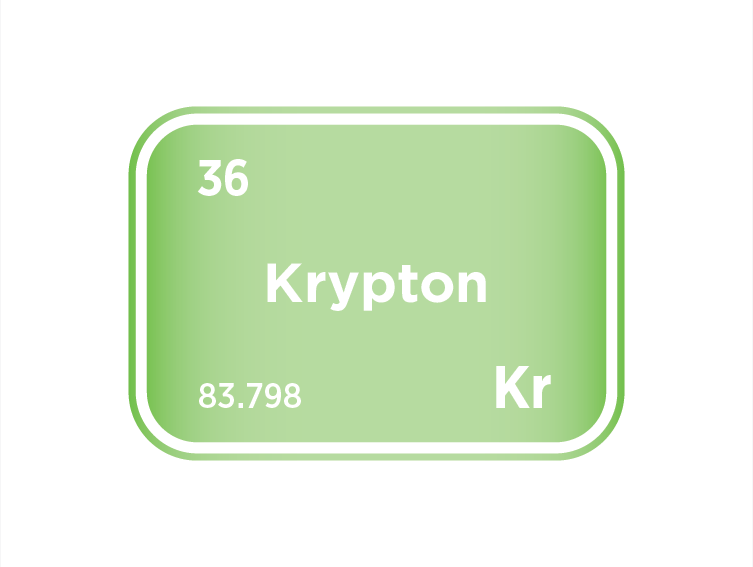
Strategic applications of Krypton
Krypton supply
Krypton is a rare atmospheric noble gas, recovered primarily as a by-product of cryogenic air separation, a process that fractionally distils atmospheric air to produce industrial gases such as oxygen, nitrogen, and argon. Because krypton makes up just 0.0001% (1 part per million) of the Earth’s atmosphere, its recovery is economically viable only at large-scale air separation units (ASUs), particularly those integrated with steelmaking, petrochemicals, or other heavy industries requiring bulk oxygen and nitrogen.
Most krypton is captured alongside other rare gases such as neon and xenon, and its supply is closely tied to the broader industrial gas infrastructure. Air separation plants must process vast volumes of air to isolate meaningful quantities of krypton, making its availability dependent on demand for primary gases like oxygen rather than on krypton demand itself.
Major producers of krypton include the United States, Russia, China, and countries within the European Union, all of which maintain extensive industrial gas processing capacity. These producers often operate within vertically integrated gas companies (e.g., Linde, Air Liquide, Air Products), where krypton is separated, purified, and liquefied as part of multi-gas recovery streams. Supply is therefore concentrated, and in some cases, subject to strategic stockpiling or allocation for defence, lighting, and high-precision manufacturing applications.
Market transparency is limited, as krypton is rarely traded independently and is instead bundled with xenon or neon in long-term industrial gas contracts. Shortages can arise when air separation output falls due to reduced steel or chemical sector demand, or when geopolitical disruptions affect key production centres, as witnessed during recent instability in Eastern Europe, where Russian output was curtailed.
Environmental and energy considerations also influence krypton supply. Air separation is highly energy-intensive, and in regions facing power constraints or energy transition pressures, some ASUs have curtailed output or prioritised essential gas flows, indirectly reducing krypton recovery. Additionally, as green steelmaking and electrification trends reduce oxygen demand from blast furnaces, krypton production may decouple from traditional baseload industrial activity.
Expanding krypton supply requires the development of new air separation units (ASUs), improvements in gas separation efficiency, or the integration of krypton recovery into emerging industrial processes such as green hydrogen production or carbon capture facilities. However, due to krypton’s extreme scarcity in the atmosphere and its dependency on the economics of oxygen and nitrogen recovery, its production is expected to remain constrained and secondary to the output of more commercially dominant industrial gases.
Krypton producers
Krypton substitution
Substitution for krypton is highly application-specific and often constrained by performance requirements, particularly in advanced lighting, electronics, and aerospace technologies. While krypton is not as irreplaceable as some critical elements, many key uses involve niche applications where alternatives may compromise efficiency, cost, or material compatibility.
In insulated glazing units (IGUs), krypton gas, due to its low thermal conductivity, is used between panes to improve thermal insulation. Argon is the most common substitute; it is far more abundant and significantly cheaper. However, while argon-filled windows are effective, krypton performs better in thinner glazing systems. As a result, the choice between krypton and argon often involves a trade-off between insulation performance and cost, with krypton used in premium or space-constrained designs and argon dominating mainstream applications.
Krypton is used in lighting and lasers for high-performance discharge lamps, including halogen bulbs, flash lamps, and excimer lasers. For most general lighting purposes, xenon or argon can be substitutes, though they may require redesigning the discharge tubes or power systems to match krypton's operating characteristics. In excimer lasers used for microlithography or LASIK eye surgery, alternative gas mixtures or fluorine-based lasers can sometimes replace krypton-containing systems, though not always without precision or equipment compatibility trade-offs.
In satellite propulsion, krypton has emerged as a cost-effective alternative to xenon in Hall-effect thrusters for electric propulsion, particularly for small satellites. However, xenon remains the performance benchmark, offering better thrust efficiency and higher storage density. The trend is somewhat reversed in this context: krypton itself is the substitute for xenon, and any shift away from krypton would either revert to xenon or consider emerging options such as iodine, though these are not yet mature.
In gas chromatography and leak detection, krypton’s properties can be mimicked by other inert gases like helium or argon, depending on the required mass or diffusion characteristics. However, the accuracy and sensitivity of measurements may be reduced.
Overall, while substitutes for krypton exist, especially argon and xenon, they often require engineering adjustments or accept lower performance. In critical applications such as aerospace, medical lasers, or ultra-efficient building materials, krypton remains difficult to replace without compromising effectiveness. Substitution is therefore driven by cost, supply constraints, or environmental design criteria rather than a complete technological shift away from krypton.



Meet the Critical Minerals team
Trusted advice from a dedicated team of experts.

Henk de Hoop
Chief Executive Officer

Beresford Clarke
Managing Director: Technical & Research

Jamie Underwood
Principal Consultant

Ismet Soyocak
ESG & Critical Minerals Lead

Rj Coetzee
Senior Market Analyst: Battery Materials and Technologies

How can we help you?
SFA (Oxford) provides bespoke, independent intelligence on the strategic metal markets, specifically tailored to your needs. To find out more about what we can offer you, please contact us.


